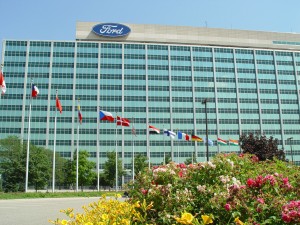
Ford's first quarter earnings fell 38%. The slide was not a surprise as it came largely from accounting changes for pensions.
Good news or bad, how Ford Motor Co. fared last year depends on how you read the numbers. The nation’s second-largest domestic automaker reported net income of $4.6 billion for all of 2016, a 38% year-over-year decline.
But Ford’s decline in net income largely resulted from accounting changes regarding pensions. The automaker actually saw adjusted, pre-tax earnings hit $10.4 billion for 2016. That was $200 million higher than expected, and marked the maker’s second-best number since 2000.
Ford had previously signaled the revisions to its pension and retirement plans would hit its pre-tax numbers to the tune of around $3 billion. Nonetheless, CEO Mark Fields called the carmaker’s overall performance, “solid,” declaring in a statement that, after factoring in the one-time hit, Ford built on the all-time record earnings reported in 2016.
“This underscores the substantial progress we are making in expanding our business to be an auto and a mobility company,” said Fields.
Fields last year said Ford would stop referring to itself as an automotive manufacturer, a shift meant to reflect its increasing focus on such things as ride- and car-sharing, as well as high-tech services and features.
The impact of that shift will likely not have much of a positive impact on Ford’s bottom line in the near-term, however, with car sales still the dominant factor. In fact, Ford on Thursday cautioned that adjusted pre-tax earnings in 2017 will likely dip as it increases investments in new technologies such as autonomous vehicles and electrified powertrains.

Ford plans to continue its significant investment in autonomous vehicles and other mobility projects.
(FiatChrysler posts nearly $2B profit for 2016. For more, Click Here.)
And shifts in the U.S. market, as well as abroad, have clearly been affecting earnings. Demand for passenger cars has been sliding as buyers increasingly opt for SUVs, CUVs and pickups. That led the automaker last April to announce plans to move its small car production to Mexico and expand U.S. production of light trucks.
The positive side is that vehicles like the Ford Explorer and F-150 generate significantly higher margins than small cars like the Focus sedan.
For the fourth quarter of 2016, Ford said it had a net loss of $800 million, a figure reflecting a number of factors, including a $200 million special charge related to its decision to cancel construction of a second Mexican assembly plant. Ford reported 20 cents a share in earnings, or 30 cents when excluding special items. Analysts had forecast a quarterly figure of 32 cents a share, down from 58 cents during the final three months of 2015.
Full year numbers were impacted not only by the accounting change but by a $600 million hit due to a large door latch recall.
(Detroit CEOs square off with new president over trade, regs, taxes. Click Here for the latest.)
How Ford will fare in 2017 depends not only on the increase in spending on new technologies but how well the overall U.S. market will perform. It is expected to slip a bit from the 17.4 million new vehicles sold in 2016 – the industry’s third consecutive record. IHS Automotive and other forecasters have estimated a dip of about 200,000 to 400,000 units for the year.
But the final numbers will likely be influenced but what the Trump Administration does with the economy as well as its trade strategy. The new president has threatened to enact a major tariff, possibly as much as 35%, on Mexican-made autos and possibly those built in other parts of the world.
Despite that pressure, and the decision to kill plans for a second Mexican assembly plant, Ford intends to go ahead with moving Ford production to Mexico. But it could face continued pressure from the White House.
The CEOs of all three Detroit makers met with Trump on Tuesday, the discussion reportedly focusing not only on trade but also the desire by the auto industry for both regulatory relief and cuts in corporate taxes.
For the moment, investors appear to be pleased with what they’re hearing, Ford stock rising on the earnings reports.
(For more on Trump scuttling the Trans-Pacific Partnership, Click Here.)
Meanwhile, Ford will now pay out $9,000 in profit-sharing to about 53,000 U.S. hourly workers. But that figure is down slightly from the record $9,300 they received a year ago.
